
NEXT
HEYCARD
designed & built by prince with
connect with me on
all socials @princemirxcle
reach out to say hi

Chunk Africa : digitizing book-keeping for thousands of businesses in Africa.
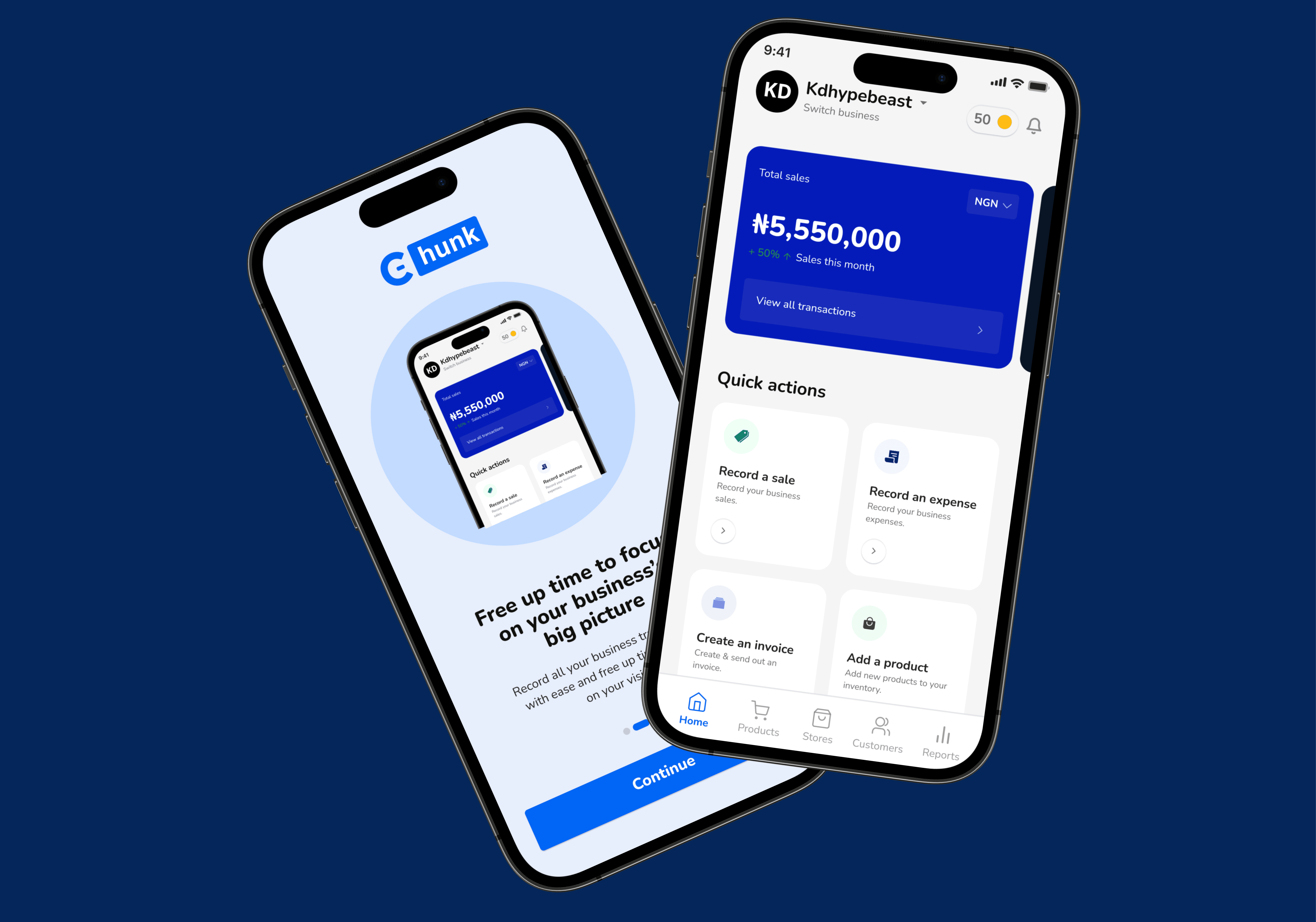
Role:
Product Design Lead
Visual Designer
UX Designer
Timeframe:
4 months
Platform
Web app
Industry
SaaS
Fintech
B2B
Overview
Chunk is an intuitive book-keeping tool designed specifically for small businesses. With Chunk, business owners can easily record sales and expenses, manage customer relationships, keep track of inventory, and generate insightful reports to help make informed decisions. What sets Chunk apart is its streamlined approach to book-keeping, making it easy for even the busiest business owners to stay on top of their finances.
With a subscription-based model, Chunk provides a stable and reliable service for thousands of active users across Africa, including paying customers.
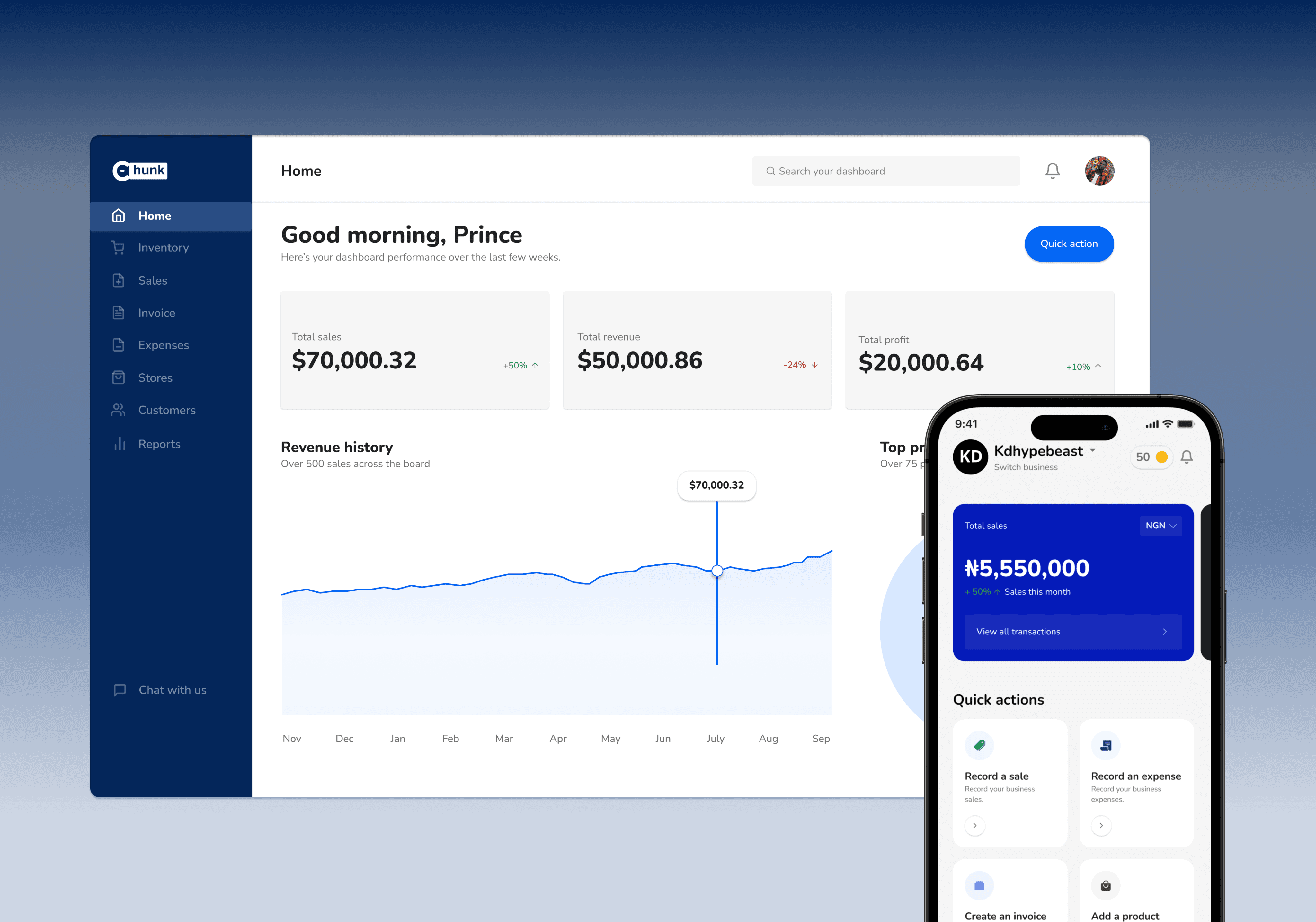
The problem with managing business’s inventory
After speaking with small business owners, we discovered a significant problem with the previous version of Chunk - inventory management was a major pain point. We learned that business owners were struggling to keep track of their inventory, which was impacting their ability to run their business effectively.
Through this experience, we realized the importance of conducting thorough user research and listening to our users' feedback. It became clear that our initial assumptions about the priorities of small business owners were incorrect, and we needed to pivot our approach to address their most pressing needs.
By incorporating this feedback into our design process, we were able to create a new version of Chunk that addressed the inventory management challenges faced by small business owners.
The market opportunity
To gain a deeper understanding of the problem space and the industry, I conducted extensive market research which validated the problem that our users were facing. Through my research, I also discovered that our competitors such as Loystar, Kippa, and Sabi were not addressing the inventory management issue effectively.
This finding highlighted a significant gap in the market, which presents a valuable opportunity for Chunk to differentiate itself from its competitors by addressing this problem.
Goals
Design a platform that helps business owners stay accountable.
Craft an easy to use interface and enable business owners add multiple businesses.
Increase activation and adoption by new users.
Increase user engagement.
How might we’s ?
Ideation: How might we’s
How might we help business owners manage their inventory and grow their business?
How might we help businesses stay accountable to their stakeholders?
How might we help businesses reduce their losses and increase their profits?
Simplified inventory management
My end-to-end research revealed that business owners were in need of a well-defined inventory management system. To address this need, I developed an all-encompassing inventory management module that provides businesses with the necessary tools to effectively manage their inventory.=
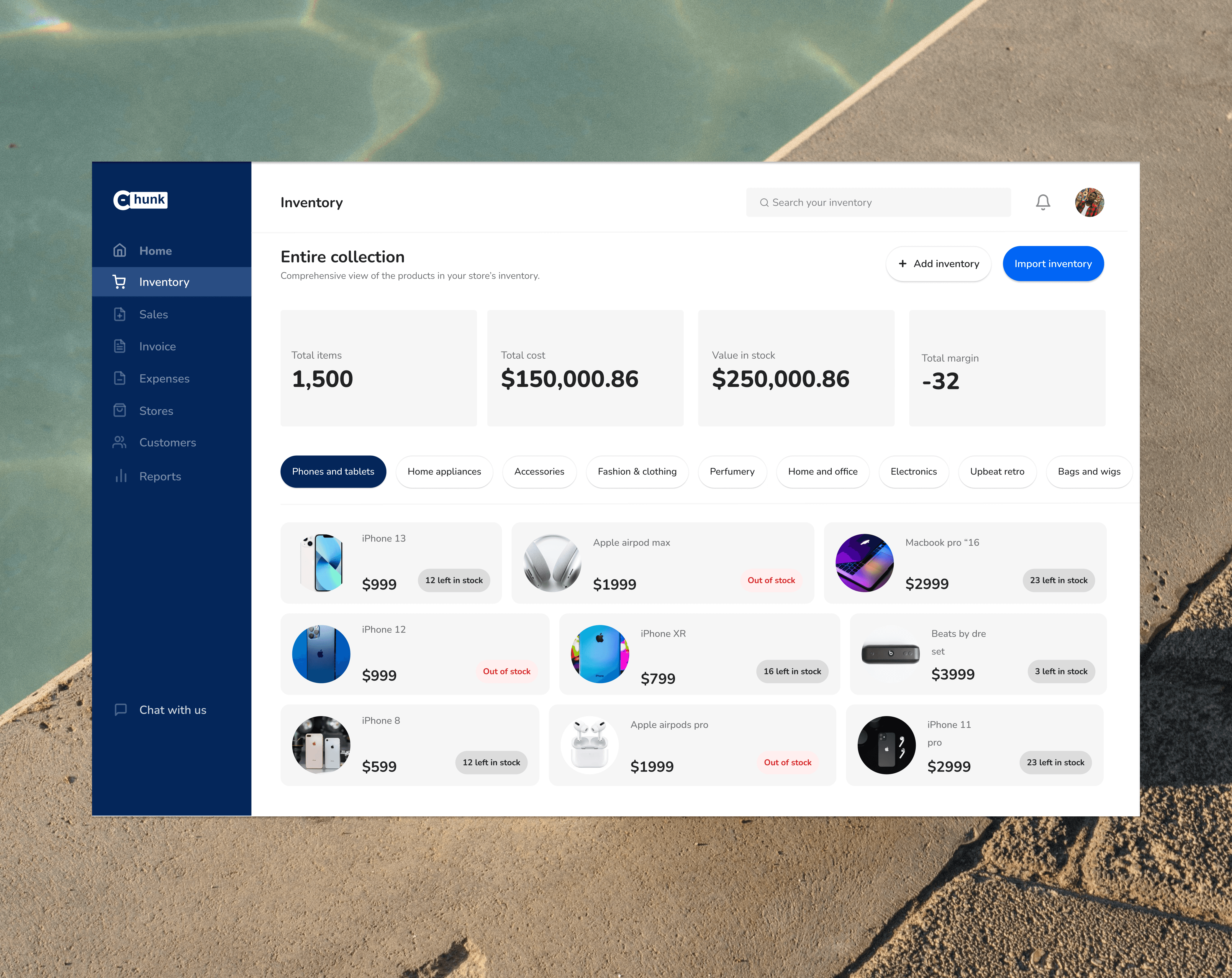
Mini CRM Tool
Our research uncovered that many business owners were struggling with managing their customer relationships. They needed a way to identify their top and frequent customers and manage those relationships effectively. To address this need, We came up with a mini-Customer Relationship Management (CRM) module that provides business owners with the tools they need to manage their customer relationships.
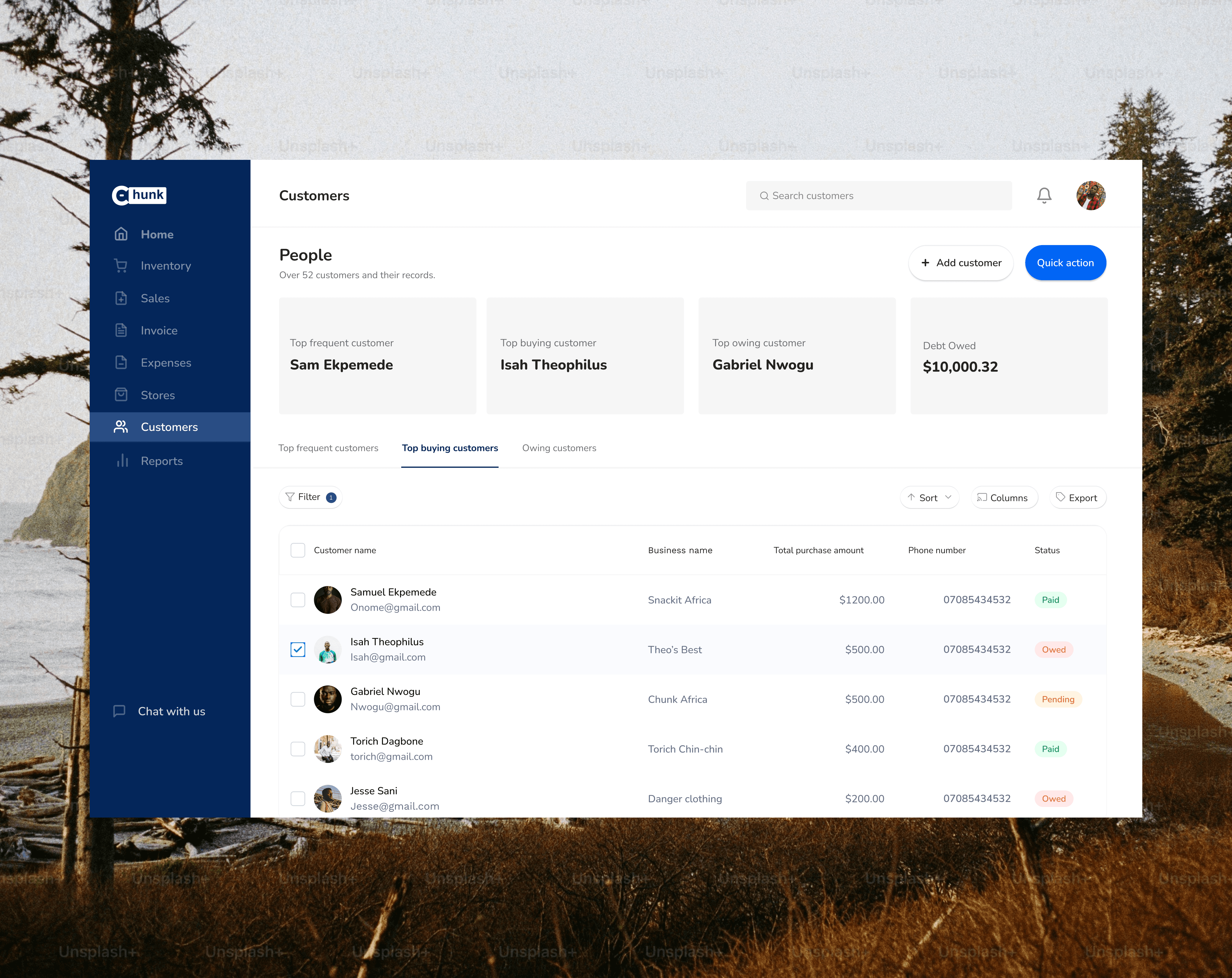
Omni-channel support for online and offline stores
In today's digital climate, many business owners sell their products online through platforms such as Flutterwave store, Paystack store-front, Jumia, Konga, and Bumpa. However, this brings up new challenges for business owners, such as how to effectively analyze insights across their online stores.
To address this challenge, I designed an omnichannel store that enables business owners to access insights from their online and offline stores.
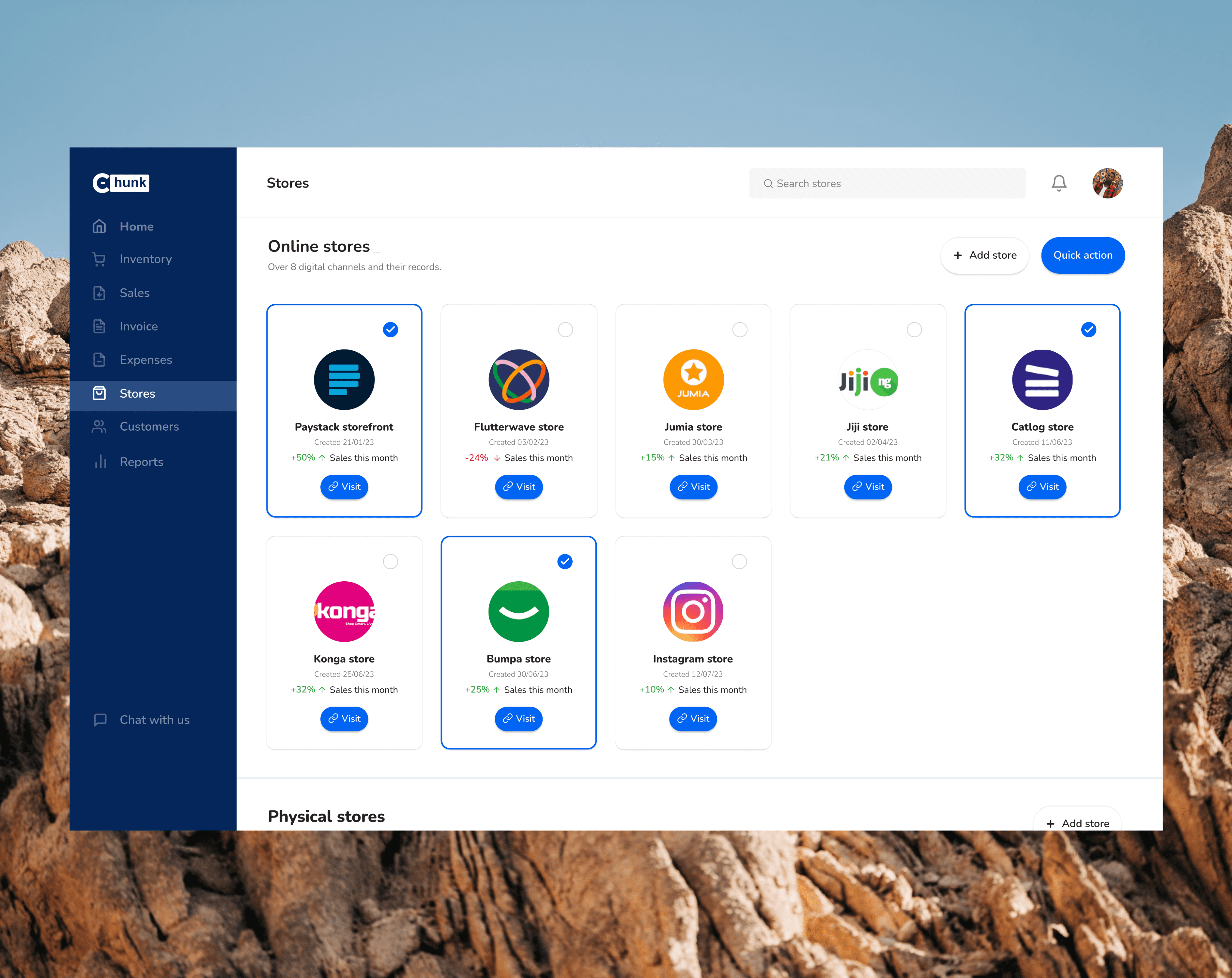
Mobile app
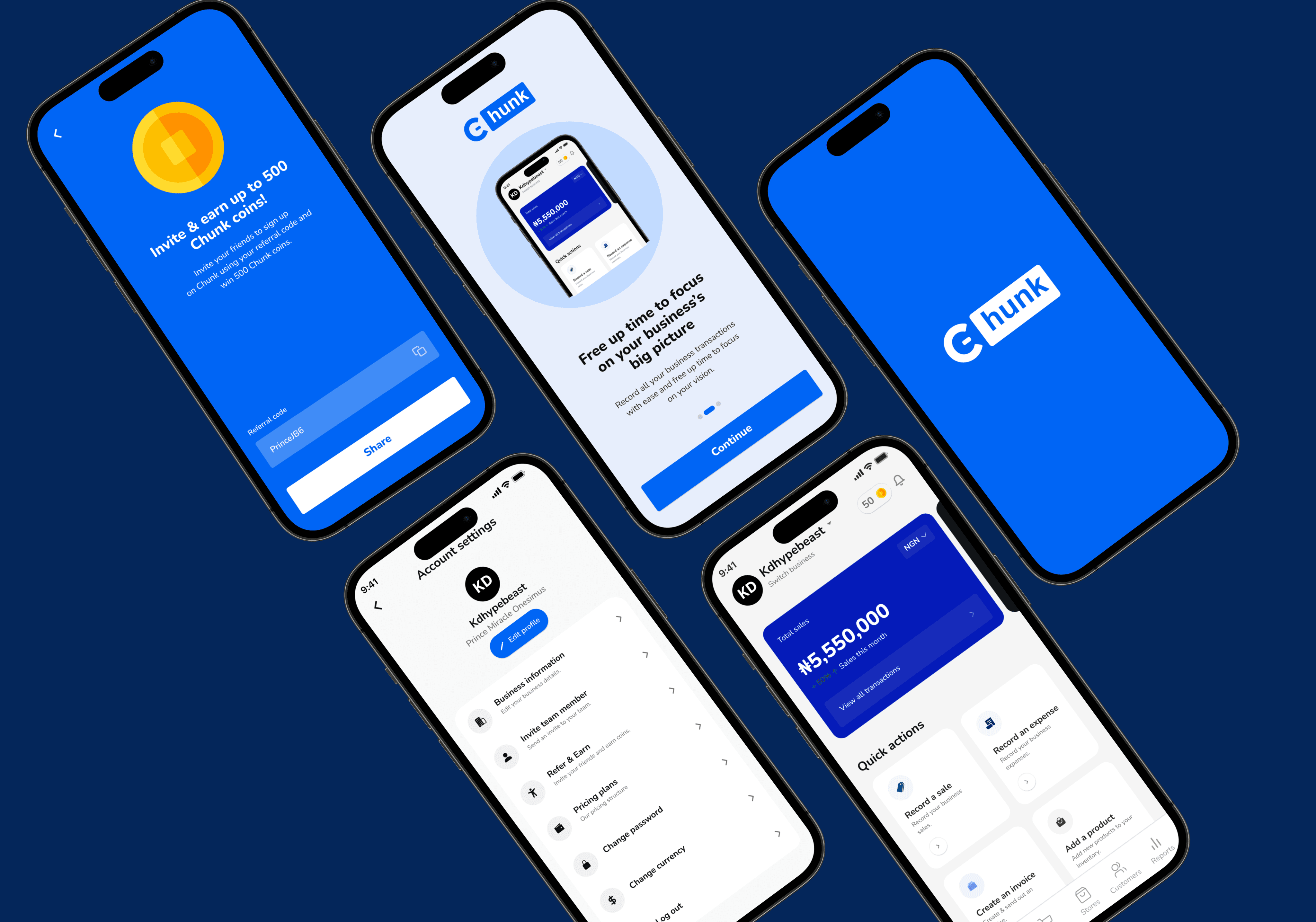
Implementation
As a member of the product team, I played a critical role in making technical decisions alongside the engineering team. Throughout the implementation process, I worked closely with the engineers to ensure that the design decisions were executed properly and to clarify any technical details that arose.
Additionally, I actively tested the product during the demo stage and provided feedback to ensure that the product was built according to my design specifications.
Learnings and takeaways
The first step in creating great design solutions is understanding the problem. To do this, designers must conduct research and gather insights to gain a comprehensive understanding of the users' needs, behaviors, and pain points.
Great product design is a team effort. Designers should collaborate closely with cross-functional teams to build a shared understanding of the problem and identify the best solutions.
Before proceeding to build a product, designers must validate their ideas to ensure that they are solving the right problems in the right way. This can involve testing prototypes with users, getting feedback from stakeholders, and measuring the success of previous solutions.
Princemirxcle
Princemirxcle











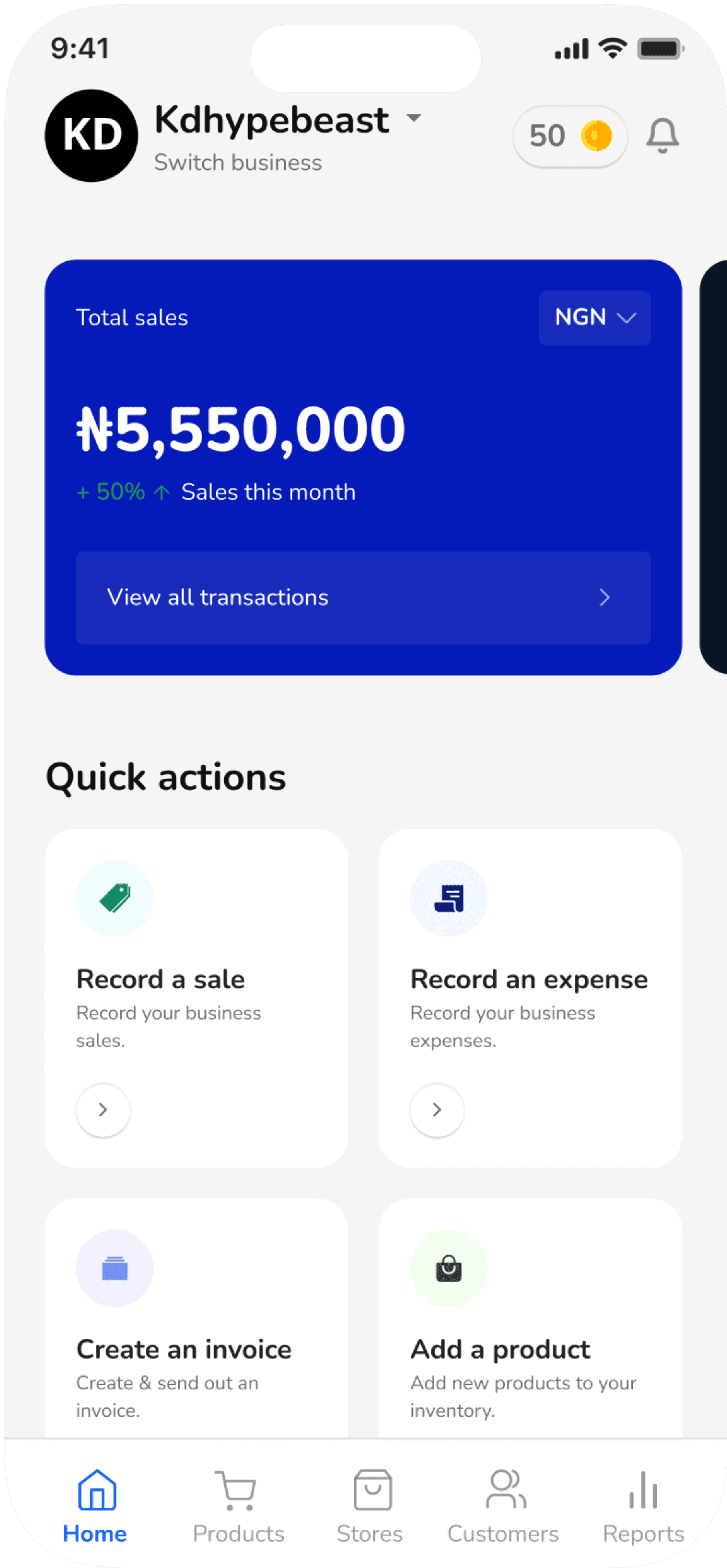





Chunk Africa: digitizing book-keeping for
African businesses.
Role:
Product Design Lead
Visual Designer
UX Designer
Brand Design
Brand Identity
Timeframe:
4 months
Platform
Mobile & Web app
Industry
SaaS
Fintech
B2B
Overview
Chunk is an intuitive book-keeping tool designed specifically for small businesses. With Chunk, business owners can easily record sales and expenses, manage customer relationships, keep track of inventory, and generate insightful reports to help make informed decisions. What sets Chunk apart is its streamlined approach to book-keeping, making it easy for even the busiest business owners to stay on top of their finances.
With a subscription-based model, Chunk provides a stable and reliable service for thousands of active users across Africa, including paying customers.
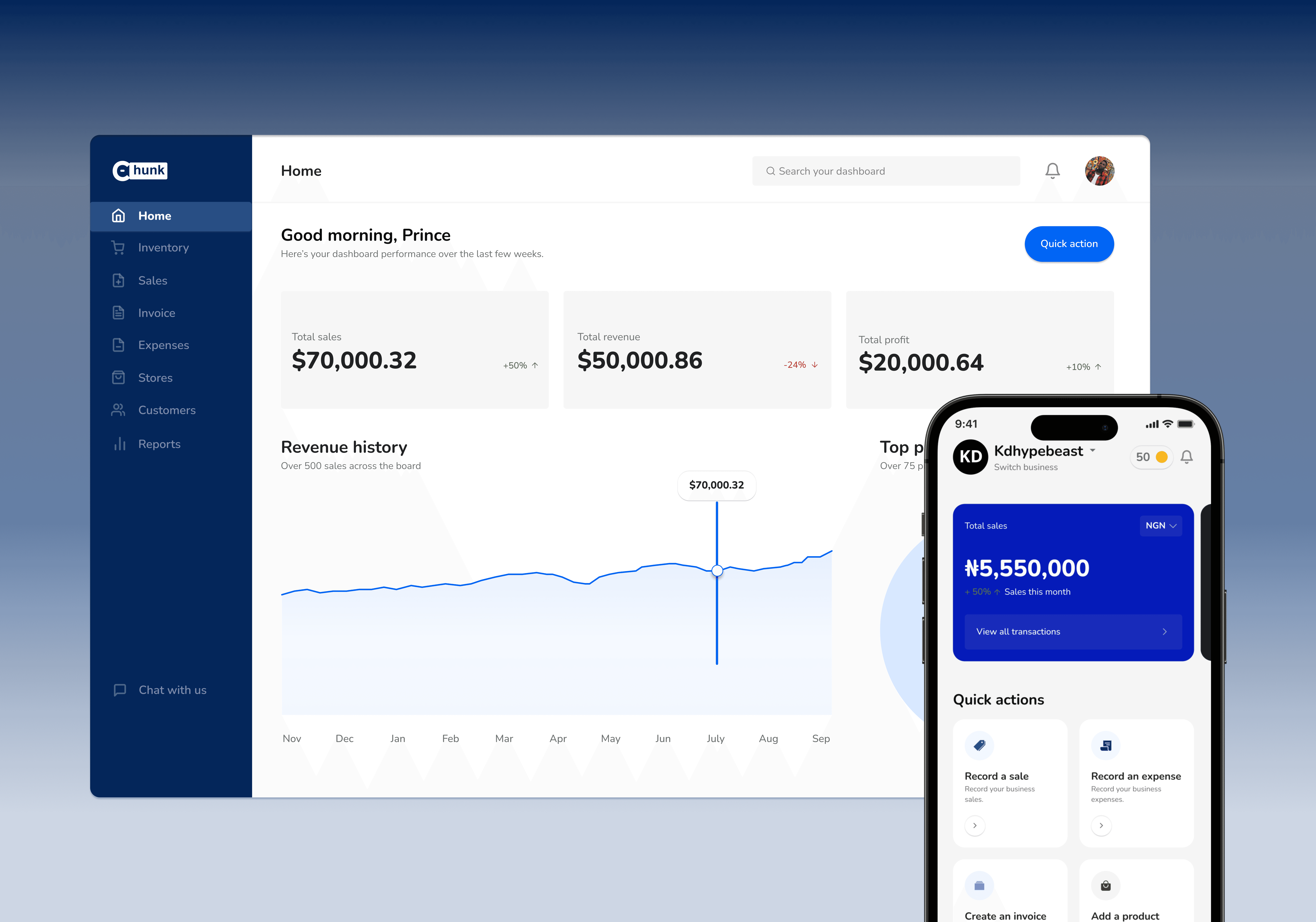

The problem with managing business’s inventory
After speaking with small business owners, we discovered a significant problem with the previous version of Chunk - inventory management was a major pain point. We learned that business owners were struggling to keep track of their inventory, which was impacting their ability to run their business effectively.
Through this experience, we realized the importance of conducting thorough user research and listening to our users' feedback. It became clear that our initial assumptions about the priorities of small business owners were incorrect, and we needed to pivot our approach to address their most pressing needs.
By incorporating this feedback into our design process, we were able to create a new version of Chunk that addressed the inventory management challenges faced by small business owners. This user-centered approach to design has resulted in a product that better meets the needs of our users and has improved their ability to run their businesses successfully.
The market opportunity
To gain a deeper understanding of the problem space and the industry, I conducted extensive market research which validated the problem that our users were facing. Through my research, I also discovered that our competitors such as Loystar, Kippa, and Sabi were not addressing the inventory management issue effectively. This finding highlighted a significant gap in the market, which presents a valuable opportunity for Chunk to differentiate itself from its competitors by addressing this problem.
Goals
Design a platform that helps business owners stay accountable.
Craft an easy to use interface and enable business owners add multiple businesses.
Increase activation and adoption by new users.
Increase user engagement.
How might we’s ?
Ideation: How might we’s
How might we help business owners manage their inventory and grow their business?
How might we help businesses stay accountable to their stakeholders?
How might we help businesses reduce their losses and increase their profits?
Simplified inventory management
My end-to-end research revealed that business owners were in need of a comprehensive and well-defined inventory management system. To address this need, I developed an all-encompassing inventory management module that provides businesses with the necessary tools to effectively manage their inventory. The module is designed to display relevant information about a business inventory in a clear and concise manner, enabling users to make informed decisions about their inventory management processes.
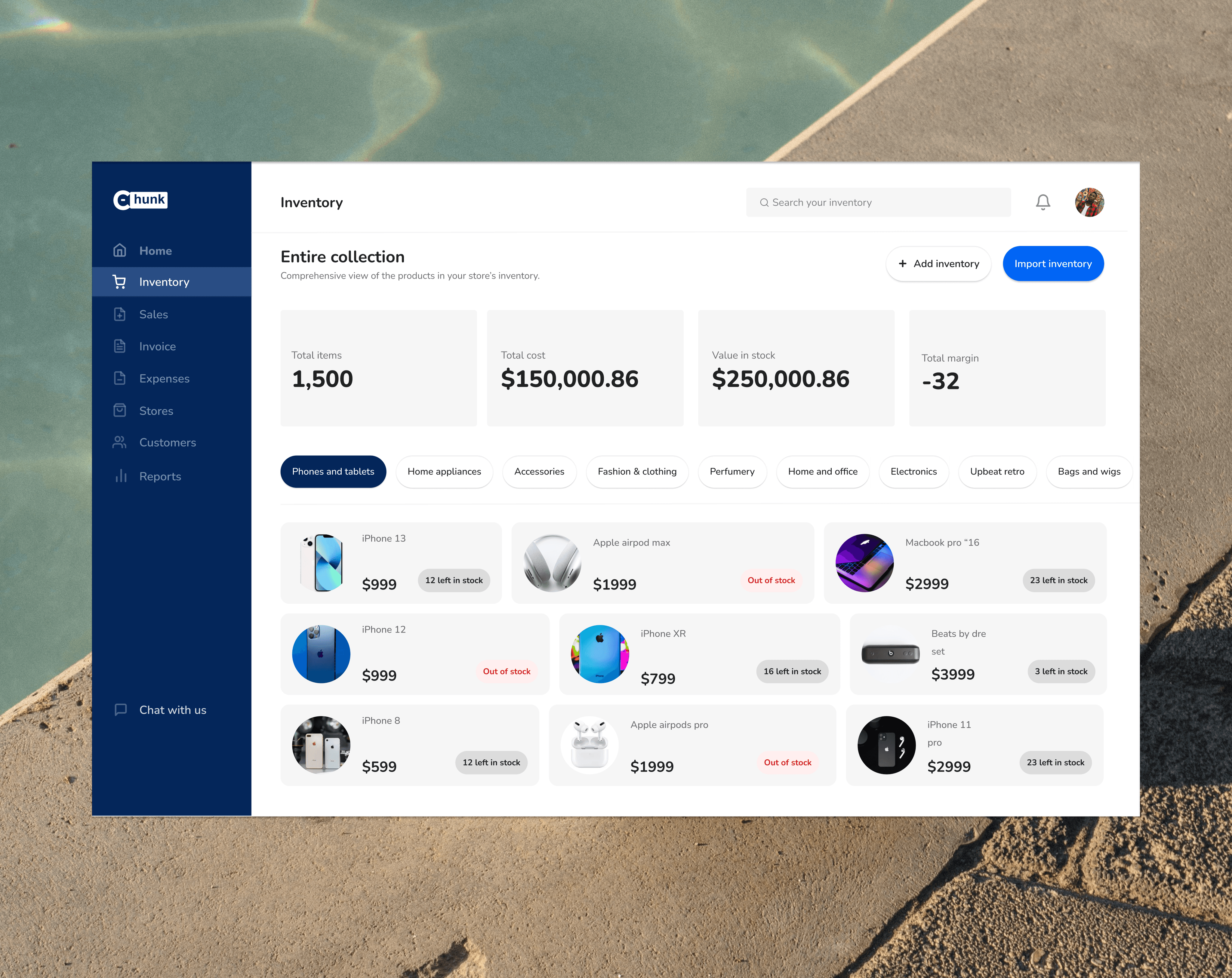

Mini CRM Tool
Our research uncovered that many business owners were struggling with managing their customer relationships. They needed a way to identify their top and frequent customers and manage those relationships effectively. To address this need, I developed a mini-Customer Relationship Management (CRM) module that provides business owners with the tools they need to manage their customer relationships more effectively.


Omni-channel support for online and offline stores
In today's digital climate, many business owners sell their products online through platforms such as Flutterwave store, Paystack store-front, Jumia, Konga, and Bumpa. However, this brings up new challenges for business owners, such as how to effectively analyze insights across their online and offline stores. To address this challenge, I designed an omnichannel store that enables business owners to access insights and data from both their online and offline stores.
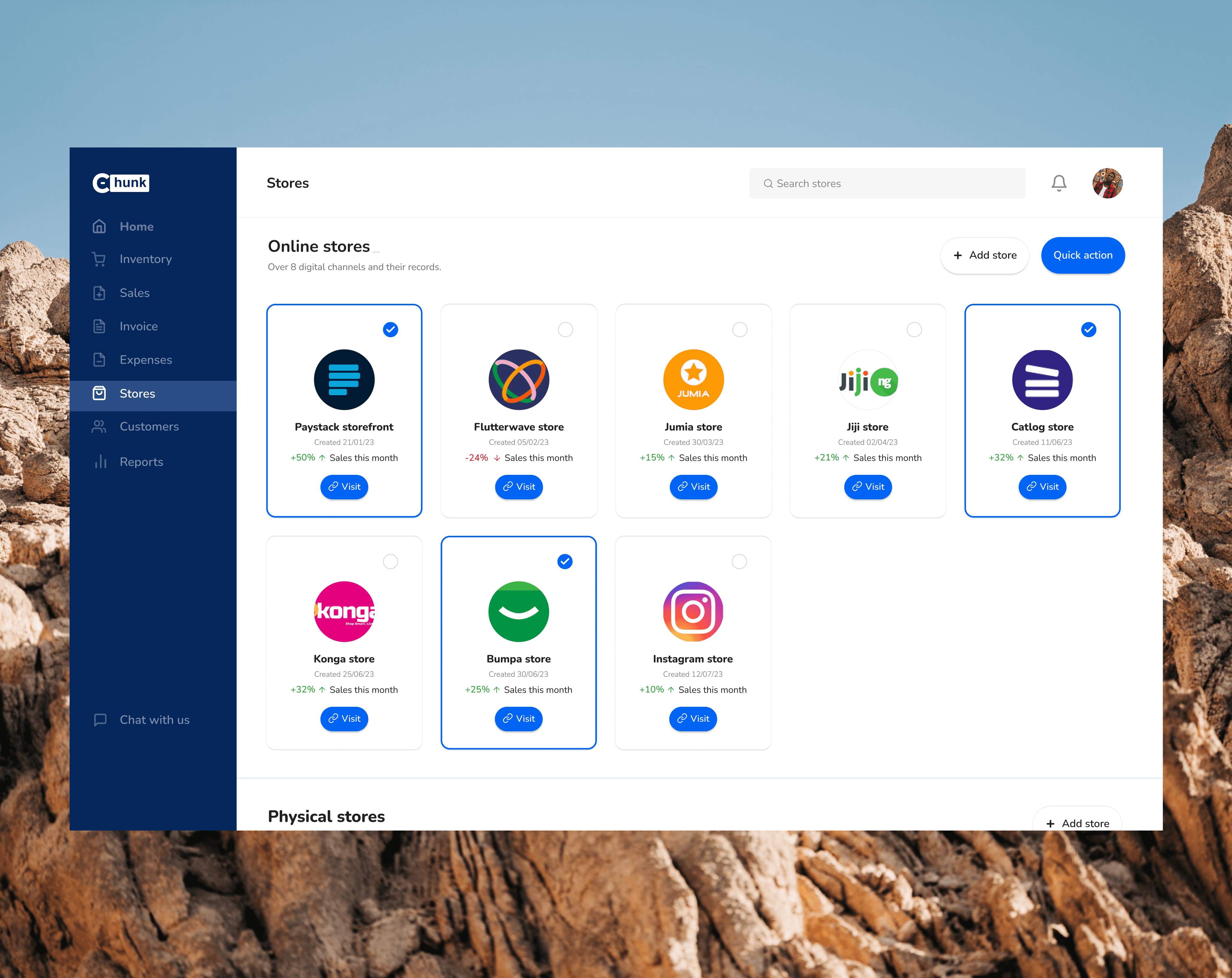
Mobile app


Implementation
As a member of the product team, I played a critical role in making technical decisions alongside the engineering team. Throughout the implementation process, I worked closely with the engineers to ensure that the design decisions were executed properly and to clarify any technical details that arose. Additionally, I actively tested the product during the demo stage and provided feedback to ensure that the final product met our design and functionality goals.
Learnings and takeaways
The first step in creating great design solutions is understanding the problem. To do this, designers must conduct research and gather insights to gain a comprehensive understanding of the users' needs, behaviors, and pain points. This knowledge will enable designers to create solutions that are tailored to their users' specific needs.
Great product design is a team effort. Designers should collaborate closely with cross-functional teams to build a shared understanding of the problem and identify the best solutions. A team-based approach ensures that everyone is aligned and working towards a common goal, resulting in better design solutions.
Before proceeding to build a product, designers must validate their ideas to ensure that they are solving the right problems in the right way. This can involve testing prototypes with users, getting feedback from stakeholders, and measuring the success of previous solutions. This process allows designers to refine their ideas and build products that truly meet their users' needs.
NEXT
HEYCARD
designed & built by prince with
connect with me on
all socials @princemirxcle
reach out to say hi






Chunk Africa: digitizing book-keeping for
African businesses.
Role:
Product Design Lead
Visual Designer
UX Designer
Brand Design
Brand Identity
Timeframe:
4 months
Platform
Mobile and Web app
Industry
SaaS
Fintech
B2B
Overview
Chunk is an intuitive book-keeping tool designed specifically for small businesses. With Chunk, business owners can easily record sales and expenses, manage customer relationships, keep track of inventory, and generate insightful reports to help make informed decisions. What sets Chunk apart is its streamlined approach to book-keeping, making it easy for even the busiest business owners to stay on top of their finances.
With a subscription-based model, Chunk provides a stable and reliable service for thousands of active users across Africa, including paying customers.


The problem with managing business’s inventory
After speaking with small business owners, we discovered a significant problem with the previous version of Chunk - inventory management was a major pain point. We learned that business owners were struggling to keep track of their inventory, which was impacting their ability to run their business effectively.
Through this experience, we realized the importance of conducting thorough user research and listening to our users' feedback. It became clear that our initial assumptions about the priorities of small business owners were incorrect, and we needed to pivot our approach to address their most pressing needs.
By incorporating this feedback into our design process, we were able to create a new version of Chunk that addressed the inventory management challenges faced by small business owners. This user-centered approach to design has resulted in a product that better meets the needs of our users and has improved their ability to run their businesses successfully.
The market opportunity
To gain a deeper understanding of the problem space and the industry, I conducted extensive market research which validated the problem that our users were facing. Through my research, I also discovered that our competitors such as Loystar, Kippa, and Sabi were not addressing the inventory management issue effectively. This finding highlighted a significant gap in the market, which presents a valuable opportunity for Chunk to differentiate itself from its competitors by addressing this problem.
Goals
Design a platform that helps business owners stay accountable.
Craft an easy to use interface and enable business owners add multiple businesses.
Increase activation and adoption by new users.
Increase user engagement.
How might we’s ?
Ideation: How might we’s
How might we help business owners manage their inventory and grow their business?
How might we help businesses stay accountable to their stakeholders?
How might we help businesses reduce their losses and increase their profits?
Simplified inventory management
My end-to-end research revealed that business owners were in need of a comprehensive and well-defined inventory management system. To address this need, I developed an all-encompassing inventory management module that provides businesses with the necessary tools to effectively manage their inventory. The module is designed to display relevant information about a business inventory in a clear and concise manner, enabling users to make informed decisions about their inventory management processes.


Mini CRM Tool
Our research uncovered that many business owners were struggling with managing their customer relationships. They needed a way to identify their top and frequent customers and manage those relationships effectively. To address this need, I developed a mini-Customer Relationship Management (CRM) module that provides business owners with the tools they need to manage their customer relationships more effectively.


Omni-channel support for online and offline stores
In today's digital climate, many business owners sell their products online through platforms such as Flutterwave store, Paystack store-front, Jumia, Konga, and Bumpa. However, this brings up new challenges for business owners, such as how to effectively analyze insights across their online and offline stores. To address this challenge, I designed an omnichannel store that enables business owners to access insights and data from both their online and offline stores.
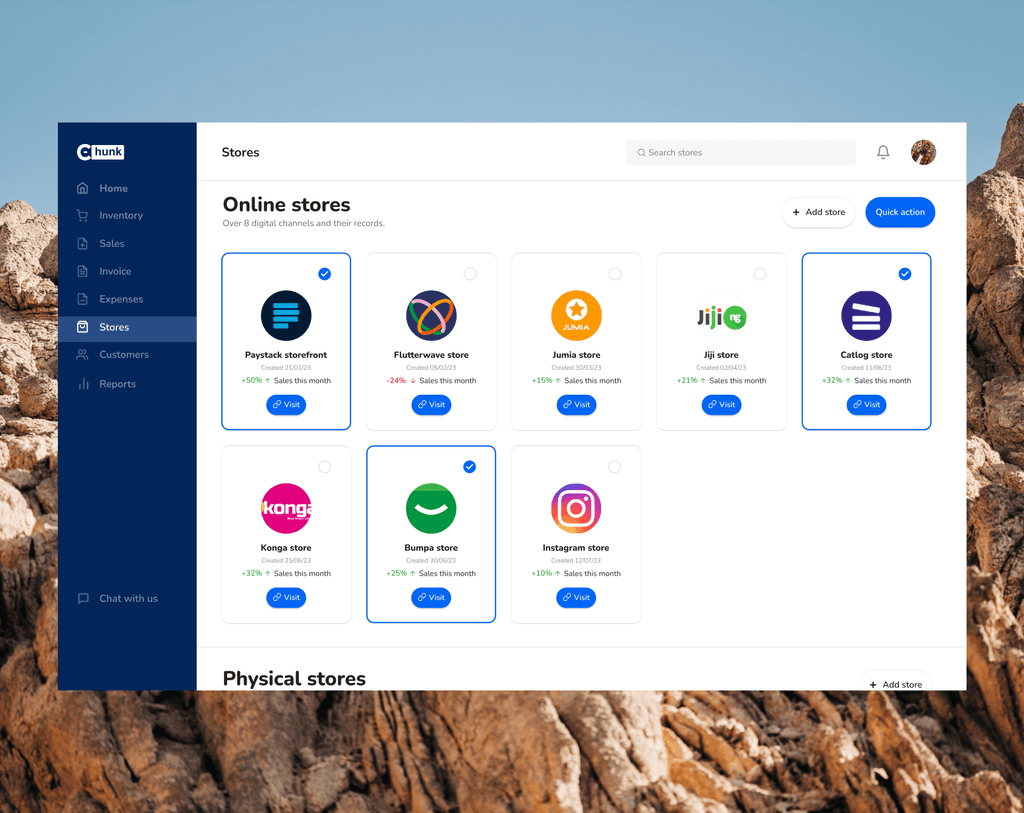
Mobile app

Implementation
As a member of the product team, I played a critical role in making technical decisions alongside the engineering team. Throughout the implementation process, I worked closely with the engineers to ensure that the design decisions were executed properly and to clarify any technical details that arose. Additionally, I actively tested the product during the demo stage and provided feedback to ensure that the final product met our design and functionality goals.
Learnings and takeaways
The first step in creating great design solutions is understanding the problem. To do this, designers must conduct research and gather insights to gain a comprehensive understanding of the users' needs, behaviors, and pain points. This knowledge will enable designers to create solutions that are tailored to their users' specific needs.
Great product design is a team effort. Designers should collaborate closely with cross-functional teams to build a shared understanding of the problem and identify the best solutions. A team-based approach ensures that everyone is aligned and working towards a common goal, resulting in better design solutions.
Before proceeding to build a product, designers must validate their ideas to ensure that they are solving the right problems in the right way. This can involve testing prototypes with users, getting feedback from stakeholders, and measuring the success of previous solutions. This process allows designers to refine their ideas and build products that truly meet their users' needs.
NEXT
HEYCARD
designed & built by prince with
connect with me on
all socials @princemirxcle
reach out to say hi


designed & built by prince with
connect with me on
all socials @princemirxcle
reach out to say hi
NEXT
HEYCARD